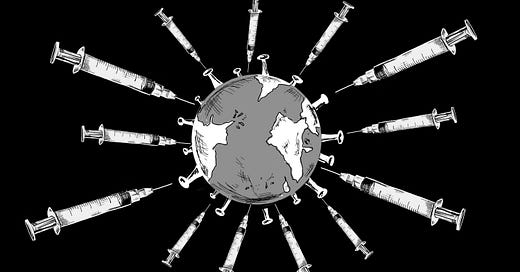The U.S. Should Vaccinate the World
And let’s get it done this year. It’s in our own best interest.
Few things warm the cockles of one’s heart these days as the images of normal life returning to places such as Israel, where more than half of the population has been fully vaccinated against COVID-19.
Yet, with just 673 million doses administered globally so far, the prospect of normalcy remains out of reach for the vast majority of humankind—and not just its poorest segments. The European Union is still struggling with vaccination, due to a combination of mishaps and bad management. In Australia, population 25 million, only 850,000 doses vaccine doses have been administered—far below the government’s original goal of 4 million doses by the end of March. In New Zealand, 1.4 doses have been administered per 100 people; in Japan, the figure is 0.9 doses per 100 people; in Taiwan, it’s just 0.1 doses per 100 people.
At the current pace, it may take years to reach global herd immunity. In the meantime, the world will become poorer, sicker, less economically interconnected, and more conflict-prone than it would otherwise be. America should not allow that to happen.
The international efforts to buy and distribute the vaccine to poorer countries are inadequate. Gavi and COVAX, the main global partnerships to disseminate the vaccines, are seeking to distribute just 2 billion doses by the end of this year, relying on a modest funding target of a little over $11 billion for 2020 and 2021—with $4 billion pledged by the Biden administration.
We should do more. Much more.
The United States ought to commit to vaccinating the whole world this year—not, or not just, as an act of charity but as an act of self-interest and leadership.
The longer it takes to reach herd immunity on a global scale, the longer we will have to live with travel restrictions and “vaccine passports,” not to speak of face masks, nasal swabs, and quarantines. The longer the wait, the more two-tiered the world, even many advanced societies, will become—with the amenities of normal life denied to large segments of the population. More worryingly, the larger the pockets of the world in which the virus continues to circulate, the greater the potential for new strains, possibly including strains resistant to the vaccines now available.
Ending this global predicament would be a bargain relative to other big-ticket items coming out of Washington these days, including the $1.9-trillion relief bill enacted last month and the infrastructure spending package now envisaged by President Biden, pegged at $2 trillion. One shot of the Pfizer vaccine, the most expensive of those currently on offer, costs the U.S. government $19.50. That would be $312 billion for 16 billion shots, more than needed to vaccinate everyone on earth and solve the world’s most pressing problem once and for all.
In comparison, in the United States alone, the pandemic might cumulatively cost $16 trillion—if it is over by this fall, that is. According to the IMF, global output will be lower by $28 trillion over 2020-2025 as a result of the pandemic. A study by the International Chamber of Commerce estimates that world GDP will be reduced by $9.2 trillion if vaccines are not distributed to poorer parts of the world fast enough.
There are significant bottlenecks to scaling up vaccine production. In normal times, building and staffing new pharmaceutical factories takes months or years. For companies such as Pfizer or Johnson & Johnson to involve outside partners in the proprietary steps of actually producing the vaccine requires the extensive sharing of intellectual property, which such companies are understandably reluctant to do—unless they are incentivized by public policy, as in the case of Merck’s partnership with Johnson & Johnson, arranged with the help of the Biden administration, in which Merck will help with the J&J vaccine’s production, formulation, and filling of vials, with federal funding provided under the Defense Production Act.
The effort to put the U.S. economy on a war footing during the Second World War faced significant bottlenecks as well, and the Roosevelt administration used every possible tool—persuasion, incentives, regulations, and outright commandeering—to meet the challenge. The current moment calls for a similar degree of urgency and willingness to commit real resources.
Few things can help American workers and companies as much as dramatically raising the growth potential of the global economy by stamping out this pandemic. The move also would buy America an unprecedented amount of political goodwill around the world, which the U.S. government could cash in at its discretion—to build a stronger global coalition to contain China and to improve the global trading system to help America’s working classes, to name just two examples.
Our adversaries, China and Russia, are already using the vaccine drought in Europe and elsewhere for their “vaccine diplomacy,” hoping for favors from America’s desperate allies, including Italy, Slovakia, and Hungary. The United States has the means to push back.
Of course, there would be any number of other complexities involved in a successful global-scale vaccination effort. Some of those complexities, like prioritization, are unavoidable. But many other problems can be left to others to solve. We need not send medical professionals around the world to administer the vaccines; it is enough to produce and ship them, and to offer advice and expertise to governments willing to handle the logistical aspects of distributing and administering doses.
Eradicating COVID-19 through a U.S.-led vaccination program is neither an overambitious fool’s errand nor a vanity project. It is a straightforward, cost-effective solution to the world’s most pressing problem—and a political opportunity waiting to be seized by leaders who dare to think big. Vaccinating the whole world quickly is eminently technologically feasible, relatively inexpensive, and guaranteed to galvanize public opinion in support of the United States against our autocratic foes. Let’s go big and—not for the first time in history—save the world.





